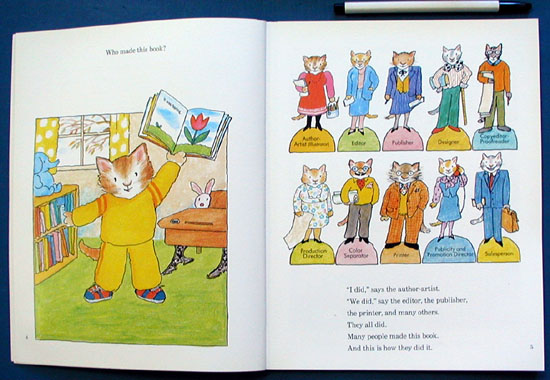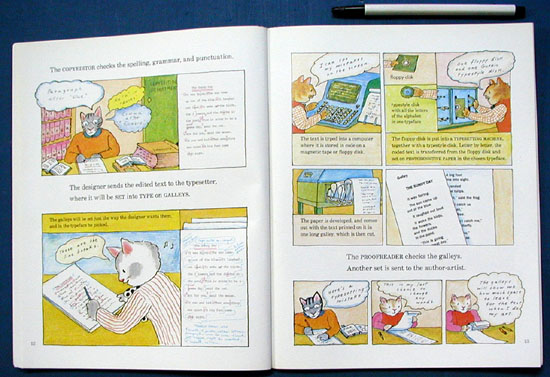|
|
|
|
 |
 이전 | 이전 |  목록 | 다음 목록 | 다음 |
|
|

상세그림 1 |

상세그림 2 |
|
확대 이미지 : 상세그림 1

|
확대 이미지 : 상세그림 2

|
[ 책 소개 ]
우리가 즐겨보는 책 1권이 완성되기 까지의 과정을 쉽고 재미있게 보여줍니다.
작가가 원고를 완성해서 출판사의 편집인에게 보내고, 원고가 채택되면 아티스트의 작업을 거쳐 초본을 완성합니다. 디자이너의 도움을 받아 전체 체제를 잡고, 교열, 교정, 그림완성, 그림교정, 비용견적, 색조교정, 페이지 조정, 인쇄, 제본, 재단, 판촉, 홍보, 배포... Wow! 수많은 사람들의 노력이 결합되어야만 책 한 권이 만들어지는군요~
[ 서지 정보 ]
Edition: Paperback: 32 pages
ISBN: 0064460851
책 크기 : 25.5cm x 20.2cm
[ 영문 서평 ]
Annotation
Describes the stages in making a book, starting with the writing of the manuscript and the drawing of the pictures, and explaining all the technical processes leading to printed and bound copies.
From the Publisher
The various steps in the making of a book can differ from one publishing house to another. This book show how this book was made.
Children's Literature
Young readers are curious about how books come into being. Encourage this curiosity. Once a child realizes that a book did not always exist but, rather, was created by an ordinary person, your child might be interested in writing her own book. Prepare to be besieged by questions: How do the hard covers get on the front and back? Who makes the pictures? One children's book writer, Aliki, in anticipation of these questions and to encourage budding authors has presented the young reader with her own book on making books. Aliki's colorful creatures illustrate aspects of bringing a book into being and the text is couched in language easily understood by young children. - Mary Quattlebaum
School Library Journal
In response to the question, ``Who made this book?,'' the eight cats pictured on the back jacket answer in unison, ``We all did!'' In only 32 pages, Aliki explains their participation in this venture, from the author's inspiration through the presentation of a copy of the completed book to a grateful child. Aliki's publishing company is in a world populated by cats, cats in fancy dress whose individual looks and personalities are representative of a wide spectrum of people. Her lucid explanation of the bookmaking process is clearer thanbut every bit as accurate asmany explanations written for adults. Younger children will be satisfied with the charming pictures and the basic picture book text, which identifies the various stages in the business of publishing books. Older or better readers, and those doing research, will find the more detailed explanations, set in smaller type within the frames of the illustrations, to be particularly worthwhile. All ages will be captivated by the dialogue balloons within the softly colored mixed media illustrations (colored pencil and watercolor), which add some humor and give the book personality. A calendar, unobtrusively placed in many of the illustrations, supplies a time frame for each step. No other author has explained the complicated process of creating a book to such a young audience. Even those readers for whom the technical aspects of book production are too difficult to grasp will appreciate the love and hard work that go into the creation of a book. Bound to please, this book marks a high spot in informational writing for children. David Gale, ``School Library Journal''
About the Author
Aliki is the author and illustrator of more than fifty books for children that are treasured by readers all over the world. Her many well-loved titles include My Visit to the Zoo, My Visit to the Aquarium, My Visit to the Dinosaurs, Wild and Woolly Mammoths, Tabby, and Those Summers. Aliki lives near the Globe theater, in London, England.
|
| * 최근 이 작품을 구입하신 분들의 다른 선택 |
Anno's Counting Book
ALA Notable Children’s Book, 페이퍼백, 슈퍼바이 |
Martin's Big Words
Caldecott수상작, 뉴욕타임즈 Best Illustrated Book, 페이퍼백, 슈퍼바이 |
The Girl Who Loved Wild Horses
Caldecott Medal 수상작, 페이퍼백 |
Violet the Pilot
페이퍼백, 슈퍼바이 |
|
| |
|
|< << [1] [2] [3] [4] [5] [6] [7] [8] [9] [10] >> >|
|
|
|